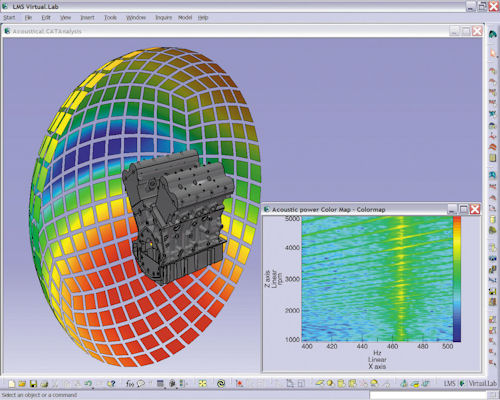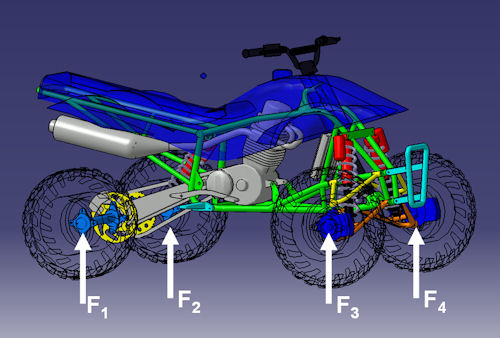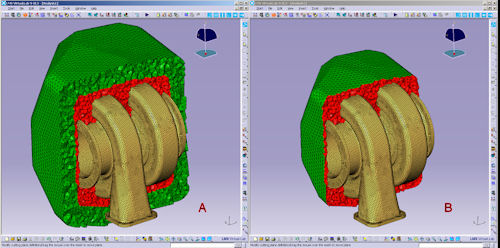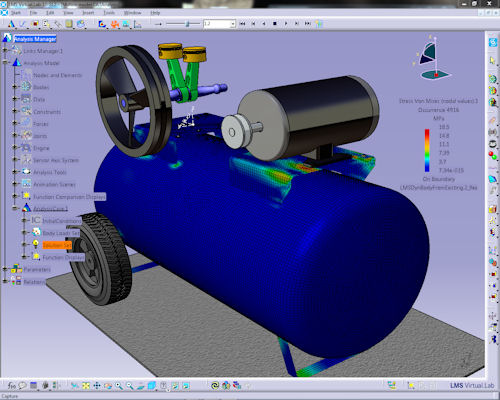Latest News
July 2, 2012
By Vince Adams
There are numerous finite element (FE)-based multiphysics (MP) applications that couple domains such as heat transfer, stress and deflection, and fluid flow. However, many mechanical products—automobiles, agricultural vehicles, power tools, etc.—have coupled multi-domain MP attributes that extend into multi-body dynamics (MBD), vibratory responses, hydraulic or pneumatic systems, often with advanced controls. LMS provides an integrated suite that captures all these attributes.
To better understand this integration, consider an internal combustion engine (ICE). The quality of an engine isn’t solely defined by its performance on a dynamometer. The engine is the primary source of sound and vibration for a car, a lawn mower or a chainsaw. The fuel consumption and emissions chemistry of the engine are some of the most examined and controlled attributes of any product in today’s eco-challenged and energy-conscious global society. Traditional stress or fluid flow simulation provide little or no input on any of these coupled attributes. (See Figure 1.)
 |
| Figure 1: Sound Power radiation plot and color map for an engine run-up event. |
Furthermore, these attributes are interdependent responses to rigid and flexible multi-body behavior, bearing fit and placement, component and assembly inertias, emissions pressure, fuel system transients—and increasingly, in electronic control strategies.
Each of these interactions can be captured in a single LMS Virtual.Lab model, leveraging system level models of fuel systems and controls from tools such as LMS Imagine.Lab or Simulink. LMS Virtual.Lab enables plant model development for real-time simulation across a variety of mechatronic systems.
LMS Virtual.Lab Solutions Architecture
LMS Virtual.Lab is a unified suite of tools that can integrate or operate independently. The products within the suite include LMS Virtual.Lab Motion, Acoustics, Durability, Noise and Vibration, Correlation, and Structures.
LMS Virtual.Lab is built off of a CAD solids-based user environment that allows geometry import from major CAD platforms, as well as native geometry construction. An integral optimization engine can incorporate solution attributes, as well as geometric parameters and dimensions. It has a model tree-based interface that should be familiar to engineers. LMS Virtual.Lab integrates other LMS products and technologies, such as LMS Imagine.Lab system models. The models are solved simultaneously for the faster response required by the real-time needs of hardware-in-the-loop (HiL).
LMS Virtual.Lab Motion
Evolving from the technology formerly known as LMS DADS, LMS Virtual.Lab Motion is an MBD solution for all types of mechanical systems. Motion has developed a feature tree-based modeling environment that is designed to improve the throughput for flexible body analysis. Flexible bodies in MBD use an FE representation that can deform naturally to the loading developed in the model, and compute stress/strain for downstream (or integrated, in the case of LMS) strength, vibration and fatigue decisions.
Version 10 introduced LMS Virtual.Lab Motion Time Waveform Replication (TWR), which is a technology for replacing simulated tire-ground interactions with measured loads acquired with wheel force transducers (WFTs). This is important for all vehicle manufacturers, but even more so for the off-road agricultural, lawncare and power sports markets. The variety of tires, and the unpredictable ground conditions, relegates simulation of these driving conditions to trend studies. However, the new Motion-TWR technology can produce realistic optimization of ride, handling and durability. (See Figure 2.)
LMS Virtual.Lab Version 11 will add a new product within Motion called LMS Virtual.Lab Composer, which allows customers to define product templates for faster new-product development. A set of templates will also be available for driving dynamics that LMS says combines its experience in this realm with algorithms and user interface design.
 |
| Figure 2: LMS Virtual.Lab Motion TWR replaces tires with actual measured road loads. |
Version 11 will also see the first collaborative enhancements stemming from LMS’ acquisition of SAMTECH, a CAE provider with advanced technology utilized by vertical industries such as aerospace and wind power. SAMTECH brings a non-linear flexible body technology, and integrated stress and modal solvers, to LMS Virtual.Lab Motion in the coming release.
LMS Virtual.Lab Acoustics
LMS Virtual.Lab Acoustics expands on the benchmark acoustic simulation engine formerly known as LMS Sysnoise, with boundary element (BEM), finite element (FEM) and, as of Version 10, ray acoustics capabilities. Solver and technology improvements in FEM acoustics have yielded new capabilities. In Version 10, LMS introduced Automatically Matched Layer (AML) FEM, touted as next-generation Perfectly Matched Layer (PML) FEM, to increase the speed of FEM acoustics. (See Figure 3.)
In standard FEM acoustics, the fluid domain surrounding the noise-generating components needed to be a mesh of generally convex shape. An ellipsoid is common. This must be sized correctly for the frequency content of the radiating noise—often increasing the mesh size of the model to between 200% and 500% of the part being studied.
 |
| Figure 3: AML technology (B) allows LMS Virtual.Lab Acoustics to achieve higher-frequency resolution with a smaller mesh compared to PML (A). |
In recent years, PML reduced the mesh requirements of FEM acoustics by allowing a smaller fluid domain that just bounds the part in question with an outer layer of mesh with non-reflecting, “infinite” fluid properties. This still requires much manual meshing on the part of the engineer, however.
Now, AML from LMS automates the domain meshing process and removes the need to model the infinite property layer. This is applied automatically during the solve. LMS says this yields a 300% improvement in solution time over traditional FEM, and 100% over PML.
In Version 11, the SAMTECH integration also comes to the aid of acoustics by enabling fully coupled vibro-acoustic solutions. This is important for lightweight structures or radiation in heavy fluids.
Beyond that, an improved boundary condition for aero-acoustics, the Surface Dipole, has been added to speed up both BEM and FEM solutions in this domain. The ray acoustics capability has been beefed up to automatically convert surface vibrations into acoustic sources, for sound quality studies in cabins or other interior structures.
LMS Virtual.Lab Durability
LMS Virtual.Lab Durability is an FE-based fatigue solver powered by the LMS FALANCS engine. LMS Virtual.Lab Durability has been benchmarked competitively in time-based, frequency or PSD-based, and thermal fatigue applications. On top of these fundamental event modes, LMS Virtual.Lab Durability provides a seam and spot-weld fatigue solver.
The seam weld solver receives major upgrades in Version 11, according to the company. These upgrades include expanded applicability to different weld types, and both thinner and thicker sheets. The utility to automatically identify welds in an FE mesh has been changed to offer speedups for large welded assemblies. This eliminates the need for engineers to model each seam weld connection manually. Welds detected can be solved with commonly accepted methodologies, from structural stress to notch stress methods, without needing to change the FE meshing. (See Figure 4.)
 |
| Figure 4: Seam welds are detected automatically in LMS Virtual.Lab Durability. |
One of the most sweeping updates to LMS Virtual.Lab Durability is an extension of the shell element seam-weld techniques to solid element meshes. Automatic detection, property application, and notch stress analysis will be available to engineers without having to create special mesh interfaces with discretely modeled notches. LMS says this will make weld fatigue analysis much more accessible to engineers in different industries.
 |
| Figure 5: LMS Virtual.Lab simulation of a compressor, integrating engine motion, deformation, acoustics, fatigue and optimization computations. |
LMS Noise, Vibration and Correlation
LMS Noise & Vibration provides an environment for evaluating the vibratory paths and responses in complex mechanical assemblies, from automobiles to assembly equipment. This product also provides the tools for linking physical testing with the simulation world. This is offered in two primary ways:
1. Vibratory response simulation is heavily dependent upon the accuracy of the modal solutions of the underlying FE models. Correlating these models to modal testing, typically through impact testing, provides a basis for confidence in the final analysis. LMS Virtual.Lab provides a deep set of modal correlation tools to ensure your model maps to reality.
2. Vibration or acoustic simulations of complex systems often include many components whose dynamic response affects the results of interest, but aren’t otherwise being evaluated. LMS Virtual.Lab Noise & Vibration allows engineers to substitute FE meshes of these parts with frequency response functions (FRFs) obtained through component testing. Using FRFs, along with LMS Imagine.Lab hydraulic, pneumatic or control models, permits engineers to use modeling representation efficiently.
Putting It All Together
LMS Virtual.Lab contains a suite of solutions for virtual product development. It is designed to integrate each of these technologies into a cohesive workflow.
Consider an all-terrain vehicle (ATV), where ride and handling must be optimized with durability, acoustics and driver vibration. An engine can be modeled in LMS Virtual.Lab Motion. The mount vibrations can propagate to the driver interfaces. The bearing loads can drive surface velocities for radiated acoustic calculations. The frequency-dependent stiffness can couple with frame and suspension models for ride and handling simulation, as well as frame durability predictions.
Frame and weld damage can be computed directly from duty-cycle events, using either actual tire-terrain interaction or TWR approximations to determine the impact handling improvements have on fatigue. Finally, various optimization algorithms can be applied across all these domains simultaneously in a single LMS Virtual.Lab database.
Vince Adams is an account manager for LMS. He is also a longtime simulation educator, consultant and speaker. He has authored three books on finite element analysis and numerous magazine articles. Contact him via [email protected].
More Info
Subscribe to our FREE magazine, FREE email newsletters or both!
Latest News
About the Author
DE’s editors contribute news and new product announcements to Digital Engineering.
Press releases may be sent to them via [email protected].






